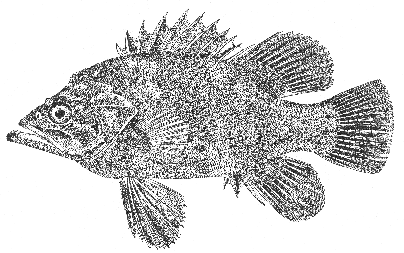Wreck fish Polyprion americanus (Bloch and Schneider) 1801
WRECK BASS
[Jordan and Evermann, 1896-1900, p. 1139.]

Figure 212.—Wreck fish (Polyprion americanus), Grand Bank. From Goode and Bean. Drawing by H. L. Todd.
Description—
The combination of a sea-bass-like body with a very rough head having a prominent ridge and strong spines on each gill cover, and a bony protuberance over the eye and on the nape, give the wreck fish an aspect so different from that of any other Gulf of Maine fish (even from its close relative the sea bass) that it should be easily recognized if caught. It is strongly flattened sidewise, about 2½ to 3 times as long as deep (to origin of tail fin), with large mouth. And the lower jaw projects considerably beyond the upper. The scales are rough, much smaller relatively than in the sea bass, and they extend over the bases of the soft-rayed fins. The first part of the dorsal fin has 11 strong spines, the second part, 11 or 12 soft rays, and the spiny part of the dorsal is continuous with the soft-rayed part. The anal fin, with 3 spines and 8 or 9 rays, is similar to the soft-rayed part of the dorsal in outline. The caudal fin is gently rounded; the pectorals [page 410] (about half as long as the head) stand almost above the ventrals.
Color—
Grayish or blackish brown, the caudal fin edged with white. Young fish are mottled above with gray and cream on head and body.
Size—
Reaches a length of 4½ to 5 feet at least, and a weight of more than 100 pounds.
Habits—
Small wreck fish are most likely to be found under floating logs or wreckage, as the common name implies. When larger, they take to bottom; this, at least, is the case around Madeira and in the Mediterranean.
General range—
This is a fish of wide distribution. In the eastern Atlantic it is known as far north as Norway, as far south as the Canaries; also in the Mediterranean. It has been reported only occasionally in the western Atlantic, but its latitudinal range there extends from the Grand Banks of Newfoundland to the La Plata River. It is also known from the Cape of Good Hope and Indian Ocean.[39]
Occurrence in the Gulf of Maine—
The only report that has reached us of a wreck fish in any part of the Gulf of Maine is of one 24½ inches long, weighing 9 pounds 7 ounces (dressed), taken on the northern edge of Georges Bank, August 13, 1951, by the trawler Winthrop.[40] Another, 6 inches long, was caught on the surface off No Man's Land Island, near Martha's Vineyard, August 21, 1925; and two have been brought in from the Grand Banks, one of them many years ago,[41] the second in 1929.[42]
[39] We have given a more detailed statement elsewhere (Copeia, 1930, No. 2, p. 46).
[40] This specimen, which we have examined, is in the collection of the U. S. Fish and Wildlife Service at Woods Hole.
[41] Goode and Bean, Smithsonian Contrib. Knowl., vol. 30, 1895, p. 238.
[42] Schroeder, Copeia, June 1930, p. 46.